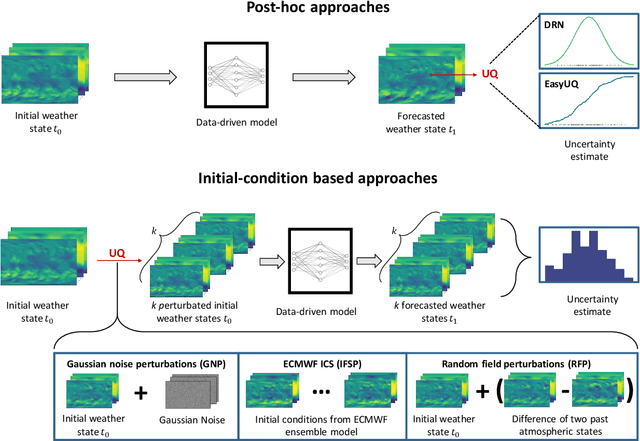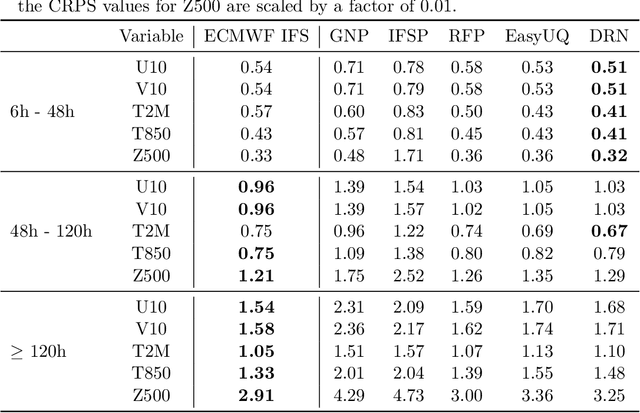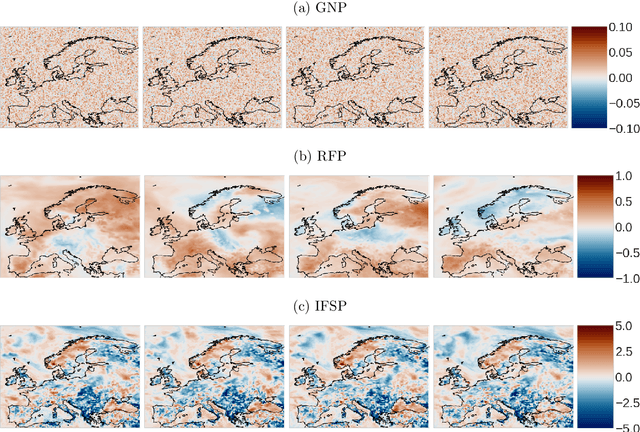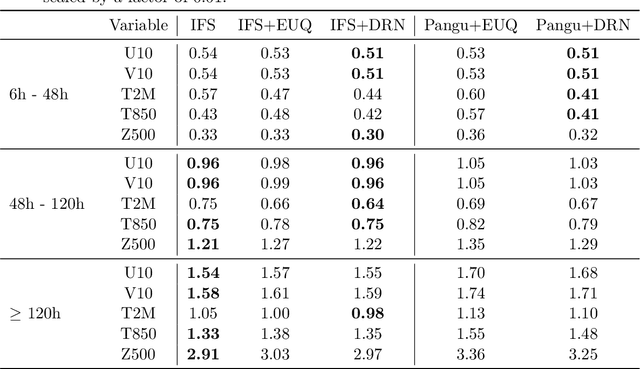Christopher Bülte
Improved probabilistic regression using diffusion models
Oct 06, 2025Abstract:Probabilistic regression models the entire predictive distribution of a response variable, offering richer insights than classical point estimates and directly allowing for uncertainty quantification. While diffusion-based generative models have shown remarkable success in generating complex, high-dimensional data, their usage in general regression tasks often lacks uncertainty-related evaluation and remains limited to domain-specific applications. We propose a novel diffusion-based framework for probabilistic regression that learns predictive distributions in a nonparametric way. More specifically, we propose to model the full distribution of the diffusion noise, enabling adaptation to diverse tasks and enhanced uncertainty quantification. We investigate different noise parameterizations, analyze their trade-offs, and evaluate our framework across a broad range of regression tasks, covering low- and high-dimensional settings. For several experiments, our approach shows superior performance against existing baselines, while delivering calibrated uncertainty estimates, demonstrating its versatility as a tool for probabilistic prediction.
An Axiomatic Assessment of Entropy- and Variance-based Uncertainty Quantification in Regression
Apr 25, 2025Abstract:Uncertainty quantification (UQ) is crucial in machine learning, yet most (axiomatic) studies of uncertainty measures focus on classification, leaving a gap in regression settings with limited formal justification and evaluations. In this work, we introduce a set of axioms to rigorously assess measures of aleatoric, epistemic, and total uncertainty in supervised regression. By utilizing a predictive exponential family, we can generalize commonly used approaches for uncertainty representation and corresponding uncertainty measures. More specifically, we analyze the widely used entropy- and variance-based measures regarding limitations and challenges. Our findings provide a principled foundation for UQ in regression, offering theoretical insights and practical guidelines for reliable uncertainty assessment.
Graph Neural Networks for Enhancing Ensemble Forecasts of Extreme Rainfall
Apr 07, 2025Abstract:Climate change is increasing the occurrence of extreme precipitation events, threatening infrastructure, agriculture, and public safety. Ensemble prediction systems provide probabilistic forecasts but exhibit biases and difficulties in capturing extreme weather. While post-processing techniques aim to enhance forecast accuracy, they rarely focus on precipitation, which exhibits complex spatial dependencies and tail behavior. Our novel framework leverages graph neural networks to post-process ensemble forecasts, specifically modeling the extremes of the underlying distribution. This allows to capture spatial dependencies and improves forecast accuracy for extreme events, thus leading to more reliable forecasts and mitigating risks of extreme precipitation and flooding.
Probabilistic neural operators for functional uncertainty quantification
Feb 18, 2025Abstract:Neural operators aim to approximate the solution operator of a system of differential equations purely from data. They have shown immense success in modeling complex dynamical systems across various domains. However, the occurrence of uncertainties inherent in both model and data has so far rarely been taken into account\textemdash{}a critical limitation in complex, chaotic systems such as weather forecasting. In this paper, we introduce the probabilistic neural operator (PNO), a framework for learning probability distributions over the output function space of neural operators. PNO extends neural operators with generative modeling based on strictly proper scoring rules, integrating uncertainty information directly into the training process. We provide a theoretical justification for the approach and demonstrate improved performance in quantifying uncertainty across different domains and with respect to different baselines. Furthermore, PNO requires minimal adjustment to existing architectures, shows improved performance for most probabilistic prediction tasks, and leads to well-calibrated predictive distributions and adequate uncertainty representations even for long dynamical trajectories. Implementing our approach into large-scale models for physical applications can lead to improvements in corresponding uncertainty quantification and extreme event identification, ultimately leading to a deeper understanding of the prediction of such surrogate models.
Estimation of spatio-temporal extremes via generative neural networks
Jul 11, 2024Abstract:Recent methods in modeling spatial extreme events have focused on utilizing parametric max-stable processes and their underlying dependence structure. In this work, we provide a unified approach for analyzing spatial extremes with little available data by estimating the distribution of model parameters or the spatial dependence directly. By employing recent developments in generative neural networks we predict a full sample-based distribution, allowing for direct assessment of uncertainty regarding model parameters or other parameter dependent functionals. We validate our method by fitting several simulated max-stable processes, showing a high accuracy of the approach, regarding parameter estimation, as well as uncertainty quantification. Additional robustness checks highlight the generalization and extrapolation capabilities of the model, while an application to precipitation extremes across Western Germany demonstrates the usability of our approach in real-world scenarios.
Uncertainty quantification for data-driven weather models
Mar 20, 2024



Abstract:Artificial intelligence (AI)-based data-driven weather forecasting models have experienced rapid progress over the last years. Recent studies, with models trained on reanalysis data, achieve impressive results and demonstrate substantial improvements over state-of-the-art physics-based numerical weather prediction models across a range of variables and evaluation metrics. Beyond improved predictions, the main advantages of data-driven weather models are their substantially lower computational costs and the faster generation of forecasts, once a model has been trained. However, most efforts in data-driven weather forecasting have been limited to deterministic, point-valued predictions, making it impossible to quantify forecast uncertainties, which is crucial in research and for optimal decision making in applications. Our overarching aim is to systematically study and compare uncertainty quantification methods to generate probabilistic weather forecasts from a state-of-the-art deterministic data-driven weather model, Pangu-Weather. Specifically, we compare approaches for quantifying forecast uncertainty based on generating ensemble forecasts via perturbations to the initial conditions, with the use of statistical and machine learning methods for post-hoc uncertainty quantification. In a case study on medium-range forecasts of selected weather variables over Europe, the probabilistic forecasts obtained by using the Pangu-Weather model in concert with uncertainty quantification methods show promising results and provide improvements over ensemble forecasts from the physics-based ensemble weather model of the European Centre for Medium-Range Weather Forecasts for lead times of up to 5 days.
 Add to Chrome
Add to Chrome Add to Firefox
Add to Firefox Add to Edge
Add to Edge